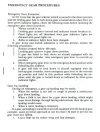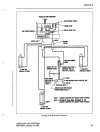The auto-extend was disabled in my plane before I got it, but the diaphragm is still under the floor, and it connects to the same valve as the emergency gear drop lever. Sometimes it's referred to as the "Hoof Valve", after the manufacturer. On my second flight in my plane we couldn't get a nose gear indication. We ran the checklist several times and tried everything we could think of. Turned out to be a bad microswitch on the nose gear, so it was working, but we didn't know that. We fixed that, but then the gear wouldn't go up.
My mechanic took the Hoof valve apart (after we learned that an overhaul was 4 figures) and found an o-ring that was damaged. He replaced that and problem solved. We believe that at one point we used the emergency gear drop with the gear switch in the up position and the pump breaker in. The pump runs whenever the switch is in the "up" position and the pressure sensor reads low pressure. In flight the gear is held up by pressure. If a hose or seal blows, the gear drops by gravity/spring pressure. The emergency lever just dumps the pressure and allows the gear to fall. By working the lever with the pump running, the flowing oil damaged (cut or dislodged, I don't remember) that o-ring.
I don't know what prevents that from happening when the auto-extender drops the gear. Maybe it does and that's your problem? The override position just prevents the diaphragm from operating the Hoof valve. The important thing in my mind is to make sure the pump breaker is pulled before using the emergency drop lever.
The indicator light system and pump are completely separate systems. The only function of the micro-switches at the gear is to light up the three lights. The pump is controlled by the gear lever, the pressure switch, and the weight-on-wheels switch.
I hope this helps. It sounds like your issue is similar, with the added complication of the auto-extender. I'd yank that thing while I'm in there if I were you.





